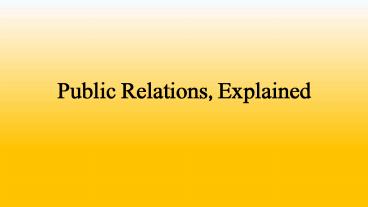Public Relations, Explained PowerPoint PPT Presentation
Title: Public Relations, Explained
1
Public Relations, Explained
2
Last month a digital marketing expert wanted to
include our firms public relations expertise in
a new business pitch. How many impressions can
you guarantee the client each week? he asked.
Hard to believe, but even a seasoned marketing
professional doesnt understand the basics of
public relations. For my friend, and all the
friends of the PR pros who read this column, the
family members who dont understand what we do,
and for entrepreneurs who need to understand
public relations and how it can help their
business, lets explain Public Relations.
3
Its not advertising. We dont buy impressions.
We dont guarantee placement. But the coverage
we get, in the media, online, social media, TV
and other places, usually has much more
credibility than paid endorsements. Public
Relations consist of the following
Persuasion Information Communication Third-party
validation Public opinion Public policy Promotion
to drive sales, revenues or donations.
4
The practice of managing the spread of
information between an individual or an
organization and the public.Public relations may
include an organization or individual gaining
exposure to their audiences using topics of
public interest and news items that do not
require direct payment.The aim of public
relations by a company often is to persuade the
public, investors, partners, employees, and other
stakeholders to maintain a certain point of view
about it, its leadership, products, or of
political decisions. Common activities include
speaking at conferences, winning industry awards,
working with the press, and employee
communication
5
The Public Relations Society of America, PRSA,
notes the concepts have been modernized. The
earliest definitions emphasized press agentry and
publicity, while more modern definitions
incorporate the concepts of engagement and
relationship building. An international effort
to update the definition led to the PRSA to
note Public relations is a strategic
communication process that builds mutually
beneficial relationships between organizations
and their publics. At least we hope so. As any
PR person who has pitched a reporter knows, and
any reporter who has to field calls from
publicists has learned, the relationship can be
mutually beneficial, antagonistic or indifferent
at any time. It depends on many factors
including the news value of the story, the
relationship between the two parties, the
reputation of the subject, and the ideology of
the media outlet.
6
The Princeton Review presents a very direct, some
would say blunt, view of the industry. A public
relations specialist is an image shaper. Their
job is to generate positive publicity for their
client and enhance their reputation. The client
can be a company, an individual or a government.
In the government PR people are called press
secretaries. They keep the public informed about
the activity of government agencies, explain
policy, and manage political campaigns. Public
relations people working for a company may handle
consumer relations, or the relationship between
parts of the company such as the managers and
employees, or different branch offices. Though
the job often involves the dissemination of
information, some view this cynically as spin
doctoring. The successful PR person must be a
good communicator-in print, in person and on the
phone. They cultivate and maintain contacts with
journalists, set up speaking engagements, write
executive speeches and annual reports, respond to
inquiries and speak directly to the press on
behalf of their client. They must keep lines of
communication open between the many groups
affected by a companys product and policies
consumers, shareholders, employees, and the
managing body.
7
Article Source http//www.forbes.com/sites/rober
twynne/2013/09/04/public-relations-explained/ Imag
e Source http//www.sefiani.com.au

